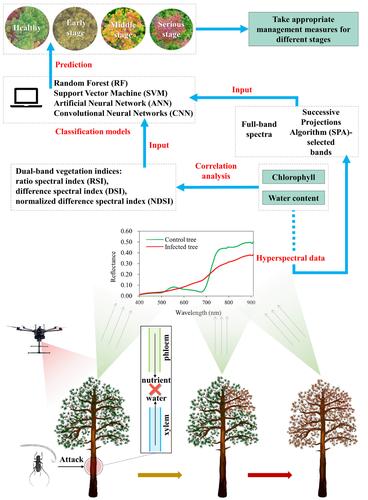当前位置:
X-MOL 学术
›
Pest Manag. Sci.
›
论文详情
Our official English website, www.x-mol.net, welcomes your
feedback! (Note: you will need to create a separate account there.)
Detection of pine wood nematode infections in Chinese pine (Pinus tabuliformis) using hyperspectral drone images
Pest Management Science ( IF 3.8 ) Pub Date : 2025-05-31 , DOI: 10.1002/ps.8938
Run Yu, Yujie Liu, Bingtao Gao, Lili Ren, Youqing Luo
Pest Management Science ( IF 3.8 ) Pub Date : 2025-05-31 , DOI: 10.1002/ps.8938
Run Yu, Yujie Liu, Bingtao Gao, Lili Ren, Youqing Luo

|
BACKGROUNDThe pine wood nematode (PWN) has caused tremendous damage to pine forests in China. Accurately predicting the infestation stage of PWN is crucial for implementing appropriate management, such as chemically controlling early‐infested trees and felling and removing trees in the severe stages of infestation. Unmanned aerial vehicle (UAV)‐based hyperspectral technology can capture images with high spatial and spectral resolutions, facilitating more extensive coverage and enhanced detection efficiency. To date, few studies have used the correlation coefficient between full spectra and physiological traits to screen dual‐band vegetation indices (VIs). Moreover, there is a lack of comprehensive comparison between the screened VIs, feature wavelengths, and full spectra using various machine learning methods to predict the infection stage of PWN.RESULTSWe evaluated the abilities of screened VIs, feature wavelengths selected by successive projections algorithm (SPA), and full spectra in estimating PWN infection levels. Random forest (RF), artificial neural network (ANN), support vector machine (SVM), and three convolutional neural networks (CNN) were applied. Screened VIs performed the best (OA%: 76.03–80.99; Kappa: 0.68–0.74), and RF approach obtained highest classification accuracies (OA%: 72.73–80.99; Kappa: 0.63–0.74). In discriminating between healthy trees and PWN‐infected trees at an early stage, RF using screened VIs outperformed other approaches (healthy trees: PA% = 76.92, UA% = 76.92; early‐infested trees: PA% = 66.67, UA% = 72.00), and normalized difference spectral index (NDSI) selected by chlorophyll content was the most sensitive feature.CONCLUSIONWe propose the integration of RF with the screened VIs as a recommended approach for the early detection of PWN infections in Chinese Pine, which give reference to the management of PWN infections. © 2025 Society of Chemical Industry.
更新日期:2025-05-31


















































 京公网安备 11010802027423号
京公网安备 11010802027423号